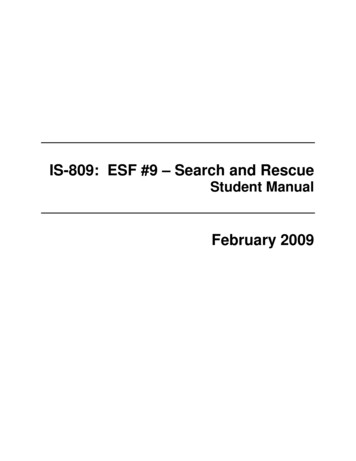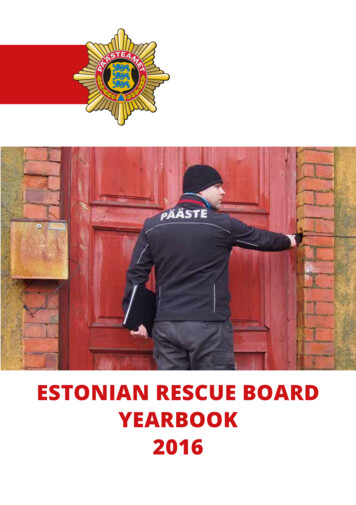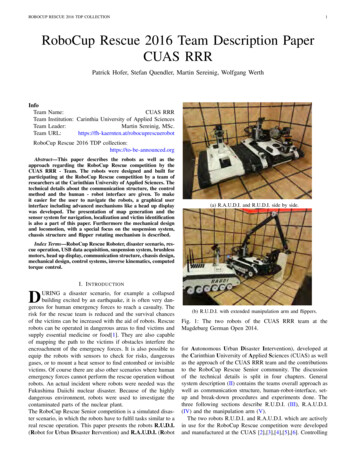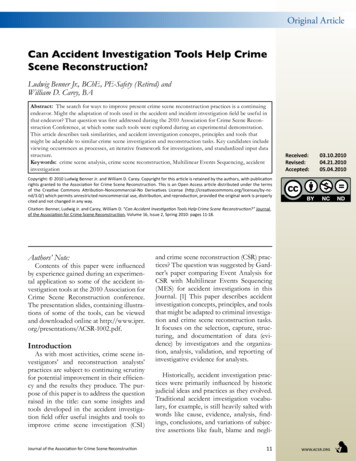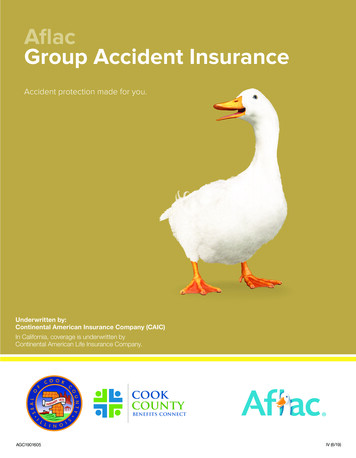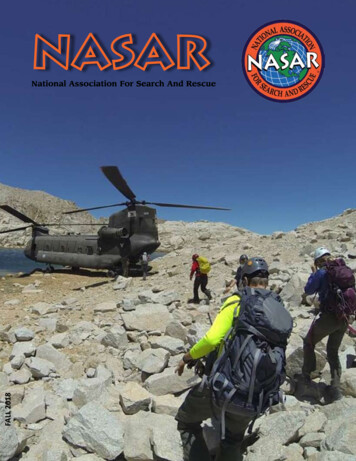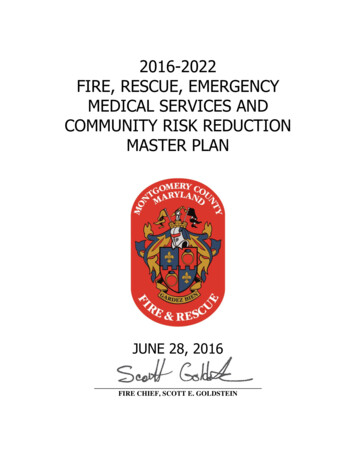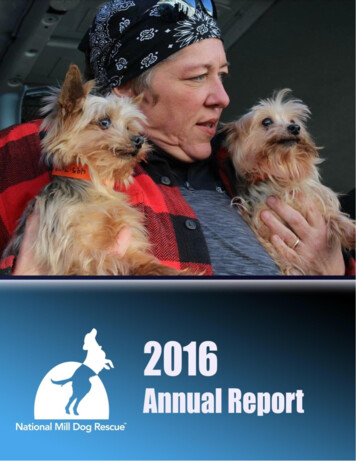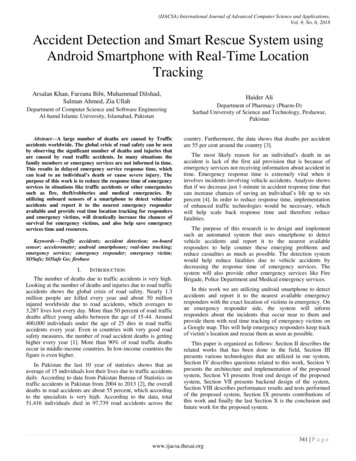
Transcription
(IJACSA) International Journal of Advanced Computer Science and Applications,Vol. 9, No. 6, 2018Accident Detection and Smart Rescue System usingAndroid Smartphone with Real-Time LocationTrackingArsalan Khan, Farzana Bibi, Muhammad Dilshad,Salman Ahmed, Zia UllahDepartment of Computer Science and Software EngineeringAl-hamd Islamic University, Islamabad, PakistanAbstract—A large number of deaths are caused by Trafficaccidents worldwide. The global crisis of road safety can be seenby observing the significant number of deaths and injuries thatare caused by road traffic accidents. In many situations thefamily members or emergency services are not informed in time.This results in delayed emergency service response time, whichcan lead to an individual’s death or cause severe injury. Thepurpose of this work is to reduce the response time of emergencyservices in situations like traffic accidents or other emergenciessuch as fire, theft/robberies and medical emergencies. Byutilizing onboard sensors of a smartphone to detect vehicularaccidents and report it to the nearest emergency responderavailable and provide real time location tracking for respondersand emergency victims, will drastically increase the chances ofsurvival for emergency victims, and also help save emergencyservices time and resources.Keywords—Traffic accidents; accident detection; on-boardsensor; accelerometer; android smartphones; real-time tracking;emergency services; emergency responder; emergency victim;SOSafe; SOSafe Go; firebaseI.INTRODUCTIONThe number of deaths due to traffic accidents is very high.Looking at the number of deaths and injuries due to road trafficaccidents shows the global crisis of road safety. Nearly 1.3million people are killed every year and about 50 millioninjured worldwide due to road accidents, which averages to3,287 lives lost every day. More than 50 percent of road trafficdeaths affect young adults between the age of 15-44. Around400,000 individuals under the age of 25 dies in road trafficaccidents every year. Even in countries with very good roadsafety measures, the number of road accident deaths is gettinghigher every year [1]. More than 90% of road traffic deathsoccur in middle-income countries. In low-income countries thefigure is even higher.In Pakistan the last 10 year of statistics shows that anaverage of 15 individuals lost their lives due to traffic accidentsdaily. According to data from Pakistan Bureau of Statistics ontraffic accidents in Pakistan from 2004 to 2013 [2], the overalldeaths in road accidents are about 55 percent, which accordingto the specialists is very high. According to the data, total51,416 individuals died in 97,739 road accidents across theHaider AliDepartment of Pharmacy (Pharm-D)Sarhad University of Science and Technology, Peshawar,Pakistancountry. Furthermore, the data shows that deaths per accidentare 55 per cent around the country [3].The most likely reason for an individual's death in anaccident is lack of the first aid provision that is because ofemergency services not receiving information about accident intime. Emergency response time is extremely vital when itinvolves incidents involving vehicle accidents. Analysis showsthat if we decrease just 1-minute in accident response time thatcan increase chances of saving an individual’s life up to sixpercent [4]. In order to reduce response time, implementationof enhanced traffic technologies would be necessary, whichwill help scale back response time and therefore reducefatalities.The purpose of this research is to design and implementsuch an automated system that uses smartphone to detectvehicle accidents and report it to the nearest availableresponders to help counter these emerging problems andreduce casualties as much as possible. The detection systemwould help reduce fatalities due to vehicle accidents bydecreasing the response time of emergency services. Thesystem will also provide other emergency services like FireBrigade, Police Department and Medical emergency services.In this work we are utilizing android smartphone to detectaccidents and report it to the nearest available emergencyresponders with the exact location of victims in emergency. Onan emergency responder side, the system will informresponders about the incidents that occur near to them andprovide them with real time tracking of emergency victims ona Google map. This will help emergency responders keep trackof victim’s location and rescue them as soon as possible.This paper is organized as follows: Section II describes therelated works that has been done in the field, Section IIIpresents various technologies that are utilized in our system,Section IV describes questions related to this work, Section Vpresents the architecture and implementation of the proposedsystem, Section VI presents front end design of the proposedsystem, Section VII presents backend design of the system,Section VIII describes performance results and tests performedof the proposed system, Section IX presents contributions ofthis work and finally the last Section X is the conclusion andfuture work for the proposed system.341 P a g ewww.ijacsa.thesai.org
(IJACSA) International Journal of Advanced Computer Science and Applications,Vol. 9, No. 6, 2018II.RELATED WORKUsing smartphones to identify road traffic accidents is not anew subject. There are completed algorithms for systemswhich utilizes accelerometer as well as GPS to detect vehicleaccidents using smartphones to detect accidents dates back to2011. Because there is already a lot done on this subject, whatwe decided to do was to develop a complete system that ismore reliable and have much more functionality than theexisting ones, designed for the ongoing project in mind.In [5] the authors developed a system which used Androidsmart-phones and ODB-II connection in a vehicle. When thesystem detects an accident, will sends an SMS to emergencycontacts specified by the user, SMS will contain informationabout the accident and also a call to the emergency services ismade automatically. All modern vehicles have ODB-IIconnection installed which transmits data about the vehicle inreal-time such as acceleration, oil pressure, speed, etc. For thesystem to work a vehicle must support OBD-II standard. In USand this standard is necessary since 2001, European countrieshave also implemented a version of this standard, so vehicles inthe US and in Europe can use this system and is not availableto all vehicle in other countries. Other than that, upgrading andmaintenance of this system is very expensive process [6].In [7], the authors at the University of Baghdad Iraqdeveloped a system which made use of the accelerometer, GPSand microphone to detect accidents. Upon detection of anaccident sends an emergency notification to the web server andalso sends an SMS to the emergency contacts, emergencyresponders have to access the web server to find out about anaccident. Their system made use of the same sensors andhardware that the algorithm presented in this research workmakes use of, except for a few features. The main issue withthis system is that the notifications are sent to a web server andresponders needs to check the web server for accidentnotification, there is no system for individual responder thatresponds to the emergency to track victim’s location and alsothe system lacks the functionality to send emergencynotification to the nearest emergency center in case there ismore than one emergency center in the area.In [8], the authors developed a system called WreckWatchwhich involves reading data from the accelerometer andacoustic data from the microphone to detect accidents. If anincident has occurred, the application contacts nearbyemergency services and provides GPS-coordinates of accidentlocation.In [9], the authors have developed an android applicationthat uses accelerometer sensor to detect accidents. Aftersensing the accident, application automatically sends a voicemessage to 108 ambulance emergency response service that isrunning in India. The issue is that this system is for specificemergency response services, only applicable in India. Also,the system is prone to increased false positives because there isno filter in place to verify if an accident detected by thesmartphone is a real accident or just false alarm due todropping smartphone, etc.In this study we looked at various technologies and existingsystems providing us with broad analysis and helped us indeveloping our system. From analysis we found that thesesystems can play a very important role in saving human lives.A new system is to be developed based on unique features thatwill help counter emergencies.III.TECHNOLOGIES UTILIZEDA. SmartphonesSmartphones are mobile phones that have considerably a lotof functionality than a regular mobile phone. they're mobilecomputers. Smartphones are powerful and versatile as a resultof built in sensors, powerful processors, multiple networkinterfaces and a high amount of memory for such smalldevices.B. AndroidAndroid is a Linux kernel based open-source mobileoperating system which was developed by Google for phones,tablets, watches, TVs, cars and other electronic devices [10].Being open-source, everyone has full access to the Androidsource code, with one restriction, it cannot be used for personalprofit or any financial gain. It is the most popular mobileoperating system.Android alternatives include iOS by Apple, WindowsPhone, BlackBerry, Symbian and a few others. We choseAndroid as it is the operating system that have the mostprogramming experience with. Android’s market dominanceand cheap application release costs were also deciding factors.C. Android StudioAndroid Studio is the primary Android IDE (IntegratedDevelopment Environment). It provides an Android developerall the necessary tools to develop an Android application. Morespecifically, it allows writing code with auto-completion tools,debugging, testing [11], running the code on a physical or avirtual device and setting programming related or visualpreferences. Java and XML are the only languages required tocreate Android applications with Android Studio [12]. AndroidStudio does not have any alternatives worth considering. It ispossible to develop Android applications with Eclipse by usingthe Android Developer Tools plugin, but it is no longersupported by Google [13].D. JavaJava is a class based general-purpose, object-orientedprogramming language [14]. It is a high-level, strongly typedlanguage with garbage collection that incorporates conceptsfrom several languages including C and C , but it is notentirely the same. For example, Java does not allow writingunsafe code that might cause vulnerabilities and unexpectedbehavior. The main building blocks of a Java application areclasses, interfaces and packages.E. AccelerometerAn accelerometer works by detecting proper accelerationaffecting the accelerometer to determine the G-forces affectingthe accelerometer [15]. Proper acceleration means accelerationthat is relative to free-fall [16]. An object in free-fall would assuch have no acceleration affecting it while an object at rest onthe surface of the earth would experience an acceleration of9,81 m/s2 upwards due to the surface pushing the object342 P a g ewww.ijacsa.thesai.org
(IJACSA) International Journal of Advanced Computer Science and Applications,Vol. 9, No. 6, 2018upwards to negate gravity. Accelerometers in smartphonesbases their functionality on micro-electromechanical-systems(MEMS), which measure electric currents based oncompression of a seismic mass, often silicon, caused byacceleration [17].objects, it automatically supports a large collection of responsetypes, including converting JSON objects into Plain Old JavaObjects. Alternative of Retrofit is Googles Volley [25], whichis also a HTTP library, for our system we chose Retrofitbecause it is light weight and has more documentation.F. Google Play ServicesGoogle Play services provide application developers acomprehensive set of useful features, for example, Maps andGoogle sign-in. The services include the Google Play servicesclient library and the Google Play services Android PackageKit. The client library makes it possible to access any featurewith a user’s account and deals with different issues that mayoccur when using the services. The Android Package Kitcommunicates with the client library and provides access to aspecific service when necessary. The use of Google Playservices is a must when using Firebase. Importantfunctionalities in Smart Rescue System, for example, viewingon a map and obtaining a user’s location also rely on theservices.L. Backend as a ServiceBackend as a Service (BaaS) is a hosted backend that hasbeen premade for developing a web or mobile application.Developers do not have to write any or much backend specificcode. It has all the necessary features of a backend and evenmore features such as Facebook and Google sign-in integrationand cloud messaging are common. The features can beaccessed by documented APIs that simplify the applicationdevelopment process.G. Google Location APIThe Google Location Services API [18] is part of GooglePlay Services, provides a more robust, high-level frameworkthat automatically chooses a suitable location provider andpower management. Location Services also provides newfeatures like activity detection which is not provided byframework API. Developers should consider using Locationservices API if they are using framework API and also if theyare making their apps location –aware.H. Android Google Map APIThe Google Maps Android API is a service which is part ofthe Google Play services library. Allows access to GoogleMaps server automatically, displaying map, downloading data,and map gesture response. It also allows to add markers,polygons, and basic map overlays, and to transition the user'scontext of a specific map area [19].I. Google Places API Web ServiceThe Google Places API Web Service is a service whichreturns information about places like locations, geographic,establishments and prominent points of interest using HTTPrequests [20]. The main alternative of Google Places API isFoursquare Venues. In free version Google Places allows150000 queries per day [21] and Foursquare Venues allows120 000 queries per day [22]. These two services are mostlysimilar, we chose Google Places API because we were morefamiliar and experienced using it.J. Google Directions APIThe Google Directions API [23] is a service that usesHTTP request to calculate distance between locations. Whencalculating directions, the API returns the most economicroutes. The API decides which route is most efficient on thebasis of travel time, number of turns, distance, etc.K. RetrofitRetrofit [24] is a type-safe HTTP client for Android andJava, provided by Square. Retrofit makes it easy tocommunicate with a web server and get back data, as javaM. FirebaseFirebase is one of many implementations of the BaaSmodel. Like other BaaS implementations, Firebase providesstorage, push notifications, user authentication and a database.Other than the basic BaaS features, Firebase also give a test labthat permits testing a Firebase connected application withdifferent configurations and devices. A feature that makesFirebase different from other BaaS implementations is the realtime database. When new data is added to the database, itbecomes accessible instantly to all the users of the application.N. Firebase Cloud MessagingFCM (Firebase Cloud Messaging) is another adaptation ofGCM (Google Cloud Messaging). It is a cross-platformmessaging solution that allows us to reliably deliver andreceive messages without any cost. Using FCM, we can sendnotification messages in order to re-engage users. [26].O. GeoFireGeoFire is an open-source library for Android/Java thatallows us to save and query a set of keys according to theirgeographic location. At its core, GeoFire simply saveslocations with string keys. Its main advantage however, is thatit allows querying key in a specific geographic area in realtime [27].IV.RESEARCH QUESTIONSSr.noResearch Questions1What are the benefits ofsuch system?2What are the researchcontributions?V.MotivationThis question will elaborate thepros and cons of accident detectionsystem.This research aims to provide acomplete system for bothemergency victims and emergencyresponders.SYSTEM OVERVIEWThe designed system consists of: SOSafe: An android application for emergencyvictims. SOSafe Go: An android application for emergencyresponders. Firebase: as Server, Database, File Storage, CloudMessaging, Auth.343 P a g ewww.ijacsa.thesai.org
(IJACSA) International Journal of Advanced Computer Science and Applications,Vol. 9, No. 6, 2018location and will send an alert notification to the nearestemergency responder (containing victim’s location) usingFCM. SOSafe will also send SMS to the emergency contactscontaining location of the victim. When emergency responderaccepts the request sent by victim, SOSafe will show real timelocation tracking of responder to the emergency victim on aGoogle map. SOSafe will also provide details about responders(name, vehicle number, phone, etc.).A. Used Servicesa) Google Play servicesb) FCM (Firebase Cloud Messaging) services.c) Firebase Realtime Databased) Firebase Authenticatione) Firebase Storagef) Google API Clientg) Google Maps APIh) Google Location APIi) Google Direction APIj) Google Places APIk) RetrofitIn case of other emergencies users can select the type ofemergency he/she is in (Fire, Ambulance, Police), then bypressing panic button the system will search and notify nearestresponders available for the selected type of emergency.2) SOSafe GoThe system also consists of an application for emergencyresponders. Responders will be able to select the type ofemergency services they provide and other information relatedto it. This application will show emergency notifications thatare sent by emergency victims and provide real time locationtracking of their locations. In case of medical emergencies, thesystem will also guide responders to a nearest hospital fromemergency location.B. Use Case Diagrams1) SOSafeFig. 1. SOSafe use case.0 shows the Top-Level Use Case of SOSafe, whichindicates the user’s full interaction with the system. It showsthe user is firstly registering himself, user can then log in to thesystem using firebase email and password authentication.He/she can view/update his profile at any time afterauthenticated. The user can turn on Automatic Monitoringwhich will register an accelerometer service running in thebackground, it can now detect all kinds of jerks produced bythe user on his/her smartphone and correctly differentiatebetween accidents and normal routine jerks.Upon detecting the right accidents, the system will generatean alert containing an alarm sound on the emergency victim’sphone. users will be able to cancel sending alert to emergencyresponders in case of false alert (accident didn’t occurred)under 15 seconds. SOSafe will get victim’s location usingGoogle Location API and save it to firebase real time database,then search for nearest emergency responders from victim’sFig. 2. SOSafe go use case.Fig. 2 shows the Top-Level Use Case of SOSafe Go, whichindicates the emergency responders’ full interaction with thesystem. It shows the responders firstly registering themselves,responders can then log in to the system using firebase emailand password authentication, responders can view/update thierprofile at any time after authenticated. Emergency responderscan then receive emergency requests from emergency victimsusing FCM.When SOSafe Go receives emergency requests, an alertwith sound and vibration triggered will be shown with locationof the emergency. When requests are accepted by the344 P a g ewww.ijacsa.thesai.org
(IJACSA) International Journal of Advanced Computer Science and Applications,Vol. 9, No. 6, 2018responders, responders will be able track the location ofemergency victims in real time on a Google map with shortestroute to location of emergency victims using GoogleDirections API. SOSafe Go will also show details aboutvictims (name, address, blood group, etc.) when emergencyvictim is rescued, if victims are in need of medical assistanceSOSafe GO will guide responders to the nearest hospital fromemergency locations by utilizing Google Places and GoogleDirections API.C. Activity Diagram0 is showing the sequence of activities held in the system.Fig. 3. Overall system activity diagram.345 P a g ewww.ijacsa.thesai.org
(IJACSA) International Journal of Advanced Computer Science and Applications,Vol. 9, No. 6, 2018Fig. 4. System sequence diagram.D. Sequence DiagramIn 0, sequence diagram shows the sequence in whichemergency victims’ application, Firebase and responders’application are performing their work.E. Firebase as BackendThe brain of the whole system is Firebase. FirebaseAuthentication is used to authenticate users by Email andPassword. Firebase Authentication also provides a number ofAuthentication API’s like Google, Facebook, GitHub, etc. Allinformation about emergency victims and emergencyresponders (availability, location. etc.) are stored at Firebasedatabase. Information about emergency requests sent fromemergency victims’ side is also stored and is processed bymatching attributes of the request to a nearest emergencyresponder available. A notification message about emergencyrequest is then sent to the available responder through FCM.Firebase is used to store real time location data, using GeoFirelibrary for Firebase. Firebase Cloud Messaging is used toexchange data and send notifications between emergencyvictim’s app and emergency responder’s app. The system willalso deal with unexpected scenarios like when there is noresponder available and avoiding false positive.F. Algorithm for Accident DetectionAlgorithm that uses on-board accelerometer sensor of asmartphone to detect accidents was developed for our systemin this research work. The question is that what to do with thevalues that are being generated by the accelerometer sensor andsetting a threshold value that will trigger the accident alert.Accelerometer delivers acceleration values for each of the threeaxes. Accelerometer values are based on (1).( )Equation (1) shows that the acceleration values that anaccelerometer sensor ( ) generates is force ( ) divided bymass (m) which is affected by gravitational acceleration (-g).Acceleration for each axes (ax, ay, az) is derived based on (1).Now we will use Pythagorean Theorem to derive valuesfrom accelerometer as shown in (2).346 P a g ewww.ijacsa.thesai.org
(IJACSA) International Journal of Advanced Computer Science and Applications,Vol. 9, No. 6, 2018 By using the value of (a) we can calculate the value of gforce (gravitational force). Equation (3) shows how g-force iscalculated.Equation (3) shows that g-force value is calculated fromacceleration (a) divided by gravitational acceleration (G). Gforce value will be approximately 1 if smartphone is resting ona table and will exceed 1 if the device is moving. Accidents canbe detected by checking if g-force value exceeds a specifiedthreshold, which in our system will be 4g, which then willgenerate an emergency alert.G. Avoiding False PositivesSince accident detection system that uses smartphone candispatch emergency services, it is necessary to avoid falsealerts. Differentiating between accidents that occurred versusdropping your phone or sudden stop is relatively hard due tosmartphone mobility. If the system cannot analyze and avoidfalse positives precisely, but can make it meaningless bywasting emergency services resources on false incident reports.We have added some features to improve our systemsreliability, accuracy and avoid false positives.Fig. 5. Log in screen (SOSafe).1) Acceleration filter prevents false positive:SOSafe will not trigger emergency event if the G-forcevalue is below 4g. This value can detect accident but will avoidtriggering emergency event on dropping a smartphone orsudden stop.2) Count down timer alert to prevent false positive:In case the system detects an accident, the system willgenerate a countdown alert dialog with sound and vibration for15 sec. in case of false alert (accident didn’t occur) the userwill be able to cancel sending emergency alert to emergencyresponder under 15 secs. This will help in reducing falsepositive, as the user will be able to cancel sending anemergency notification in case of false event.VI.FRONT END DESIGNA. SOSafeEmergency victims’ side application SOSafe is developedin Java programming language using Android Studio as IDE.This prototype application is developed for android operatingsystem having a minimum API level 17, and target API level26. The application is fully working and implemented on theAndroid smartphone.Fig. 6. Sign up screen (SOSafe).Fig. 5 shows log in screen of SOSafe, users can use emailand password that they used to register, to log in to the system.After users logs in to the system, they will be able to use allsystem features.Fig. 6 shows sign up screen of SOSafe, users providesemail, password and other details (name, phone and bloodgroup) in order to register. After registration all informationwill be saved at Firebase database.347 P a g ewww.ijacsa.thesai.org
(IJACSA) International Journal of Advanced Computer Science and Applications,Vol. 9, No. 6, 2018Fig. 9. Panic button (SOSafe).Fig. 7. Navigation drawer (SOSafe).Fig. 10. Auto monitoring/auto accident detection (SOSafe).Fig. 8. Home screen (SOSafe).Fig. 7 shows navigation drawer of SOSafe, users can viewhistory of previous emergencies, update their information, addemergency contacts numbers, change password and sign out.Fig. 8 shows home screen of SOSafe, user can turn on AutoMonitoring for automatic accident detection or send emergencyrequest manually.Fig. 9 shows Panic Button feature of SOSafe, users canselect the type of emergency service and press “RequestEmergency” button to manually send an emergency request toselected emergency service responder near to them.Fig. 10 shows, users of SOSafe can turn on “AutomaticMonitoring”, the system will register an accelerometer servicerunning in background; it can now detect accidents.348 P a g ewww.ijacsa.thesai.org
(IJACSA) International Journal of Advanced Computer Science and Applications,Vol. 9, No. 6, 2018Fig. 11. Panic button alert dialog (SOSafe).Fig. 13. Responder details (SOSafe).Fig. 12. Accident detected alert dialog (SOSafe).In Fig. 11, when user of SOSafe presses the panic button,the system will present an alert dialog to confirm the actionbefore sending an emergency request to responder, this willhelp in situations when panic button is pressed accidently.In Fig. 12 when SOSafe detects an accident, will present analert dialog with a 15 sec count down timer, in case of falsealert the user can abort sending request by pressing “Cancel”button. If there is no response from the user in 15 sec, it will beconsidered as an actual accident and the system will send anemergency alert to the nearest emergency responder and also tothe emergency contacts.Fig. 14. Real time tracking of responder (SOSafe).Fig. 13 shows, when an emergency request sent byemergency victim is accepted by emergency responder,SOSafe will show details about that responder to the victim.In Fig. 14, SOSafe will show real time location ofemergency responder on a Google map to the emergencyvictim.349 P a g ewww.ijacsa.thesai.org
(IJACSA) International Journal of Advanced Computer Science and Applications,Vol. 9, No. 6, 2018B. SOSafe GoEmergency responders’ side application SOSafe Go isdeveloped in Java programming language using AndroidStudio as IDE. This prototype application is developed forandroid operating system having a minimum API level 17, andtarget API level 26. The application is fully working andimplemented on the Android smartphone.Fig. 17. Home screen (SOSafe Go).Fig. 15. Log in screen (SOSafe Go).Fig. 16. Sign up screen (SOSafe Go).Fig. 18. Navigation drawer (SOSafe Go).Fig. 15 shows log in screen of SOSafe Go, emergencyresponder can use email and password that they used toregister, to log in to the system. After emergency responderslogs in to the system, they will be able to use all systemfeatures.Fig. 16 shows sign up screen of SOSafe Go, emergencyresponder needs to provide email and password and name inorder to register. After registration all information will besaved at Firebase database.Fig. 17 shows home screen of SOSafe Go, responders canturn on the switch to go Online, responders can now receiveemergency requests sent by emergency victim.Fig. 18 shows the navigation drawer of SOSafe Go,emergency responders can view history of previousemergencies, update their information, change password, andselect the type of emergency services they provide, e.g. FireBrigade, Police Department or Ambulance.350 P a g ewww.ijacsa.thesai.org
(IJACSA) International Journal of Advanced Computer Science and Applications,Vol. 9, No. 6, 2018Fig. 21. Real time tracking of victim (SOSafe Go).Fig. 19. Emergency alert screen (SOSafe Go).Fig. 22. Nearby hospital route (SOSafe Go).In Fig. 21, SOSafe Go will show real time location ofemergency victim on a Google map to the emergencyresponder.In Fig. 22 shows, upon rescuing emergency victim, if thevictim is in need of medical assistance, SOSafe Go will guideemergency responders to the nearest hospital from emergencylocation.VII. BACK ENDFig. 20. Victim’s details (SOSafe Go).In Fig. 19, when SOSafe Go receives an emergencyrequest, the system will show an emergency alert screen to theresponder with sound and vibration turned on. Emergencyresponder can press “Navigate” button to get direction to theemergency location.Fig. 20 shows, when an emergency request by emergencyvictim is accepted by emergency responder, SOSafe Go willshow details (name, phone, blood group, and address) aboutthat
Accident Detection and Smart Rescue System using Android Smartphone with Real-Time Location Tracking Arsalan Khan, Farzana Bibi, Muhammad Dilshad, Salman Ahmed, Zia Ullah Department of Computer Science and Software Engineering Al-hamd Islamic University, Islamabad, Pakistan Haider Ali Department of Pharmacy (Pharm-D)

